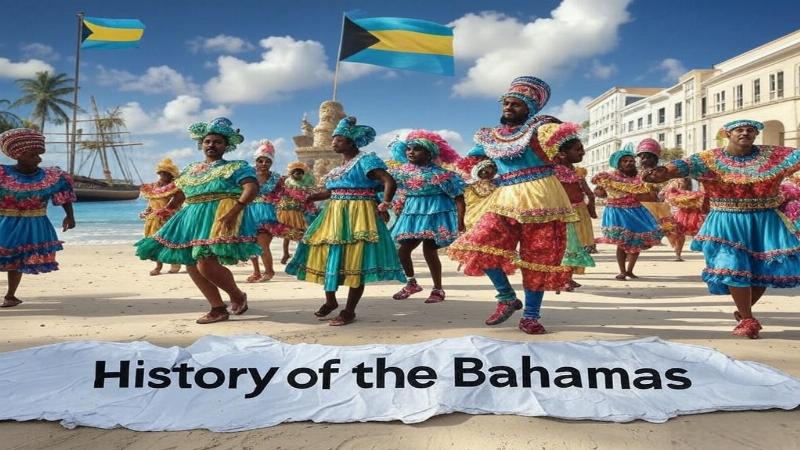Place for ads

The Bahamas, an archipelago of over 700 islands and cays scattered across the Atlantic, is a tropical paradise with a history as vibrant as its turquoise waters. Covering 13,878 square kilometers, this nation north of Cuba and east of Florida has evolved from a home for indigenous tribes to a playground for pirates, a British colony, and now a modern tourism hub. Known for its beaches and laid-back charm, the Bahamas’ past is a tale of resilience, exploitation, and reinvention. In this article, we’ll dive into the Bahamas’ history, tracing its journey from ancient times to today, and uncovering the forces that shaped its unique identity.
The Bahamas’ human story begins around 500 CE, when the Lucayan people—part of the broader Taíno Arawak group—arrived from Hispaniola or Cuba. Crossing the sea in dugout canoes, they settled islands like Grand Bahama, Abaco, and San Salvador. Archaeological sites, such as the Long Island caves, reveal their lives—fishing, growing cassava, and crafting pottery.
The Lucayans thrived in harmony with their environment, numbering around 30,000 by the 15th century. Their villages dotted the cays, sustained by conch and trade with neighbors. This peaceful existence lasted nearly a millennium until
Place for ads
On October 12, 1492, Christopher Columbus made landfall in the Bahamas—likely on San Salvador, though the exact spot is debated—naming it “San Salvador” and claiming it for Spain. He described the Lucayans as friendly, but their fate was grim. Within decades, Spanish raiders enslaved them, shipping thousands to Hispaniola’s mines and plantations.
By 1520, the Lucayan population had vanished—wiped out by disease, overwork, and displacement. The Bahamas lay deserted, their islands deemed useless by Spain due to a lack of gold. For over a century, they remained a quiet backwater, visited only by occasional sailors and shipwrecks.
The 17th century saw the Bahamas emerge as a pirate stronghold. Its shallow waters and hidden cays—perfect for ambushing ships—drew buccaneers like Blackbeard (Edward Teach) and Anne Bonny. Nassau, on New Providence, became their base, a lawless den of rum, loot, and revelry from the 1690s to the 1720s.
Spain and Britain clashed over the region, but neither fully controlled it. Pirates preyed on treasure-laden galleons, amassing fortunes until Britain stepped in. In 1718, Governor Woodes Rogers arrived, offering pardons or gallows. His campaign—“Expel the pirates or perish”—tamed Nassau, ending the Golden Age and ushering in colonial rule.
Britain claimed the Bahamas in 1670, but serious settlement began after Rogers’ arrival. English colonists from Bermuda, joined by Loyalists fleeing the American Revolution in the 1780s, established plantations. Cotton briefly boomed, especially on Cat Island and Exuma, fueled by enslaved Africans brought via the transatlantic trade.
By 1807, when Britain abolished the slave trade, over 11,000 enslaved people lived in the Bahamas—outnumbering whites 3 to 1. Conditions were harsh, though some gained freedom through manumission. The cotton economy faded by the 1820s due to soil depletion, shifting focus to salt production and fishing.
Slavery ended in 1834 with Britain’s Emancipation Act, freeing over 10,000 Bahamians. Unlike other colonies, the Bahamas skipped the apprenticeship phase, granting immediate liberty. Freed people formed “Out Island” communities—self-sufficient villages on Andros and Eleuthera—relying on fishing and small farms.
Economic hardship followed. The Bahamas turned to “wrecking”—salvaging shipwrecks—and blockade-running during the U.S. Civil War (1861–1865), smuggling goods to the Confederacy. Nassau thrived briefly, but peace in 1865 plunged it back into poverty, a colonial backwater reliant on subsistence.
The early 20th century brought change. American tourists, lured by Nassau’s climate, sparked a fledgling industry—hotels like the Royal Victoria opened in the 1860s, but growth surged post-World War I. The U.S. Prohibition (1920–1933) turned the Bahamas into a rum-running hub, with bootleggers like Gertrude Lythgoe thriving near Florida.
World War II boosted the Bahamas’ strategic role. Britain trained RAF pilots here, while the U.S. built bases under the 1940 Lend-Lease deal. Post-war, tourism boomed—air travel and cruise ships made Nassau and Freeport accessible, laying the groundwork for modern prosperity.
The mid-20th century saw calls for self-rule. The Progressive Liberal Party (PLP), led by Lynden Pindling, championed Black majority rights against the white-led United Bahamian Party (UBP). The 1967 election gave the PLP power, ending centuries of minority rule. On July 10, 1973, the Bahamas gained independence, with Pindling as its first prime minister.
The new nation kept Queen Elizabeth II as monarch, represented by a governor-general. Early years focused on nation-building—education, infrastructure—but drug trafficking in the 1980s, tied to Colombia, tarnished its image. Pindling’s 25-year rule ended in 1992 amid corruption allegations.
Today, the Bahamas’ 400,000 people rely on tourism—over 7 million visitors annually flock to Nassau, Grand Bahama, and the Exumas. Resorts, casinos, and events like Junkanoo—a vibrant street festival—drive the economy, alongside offshore banking. Hurricanes, like Dorian in 2019, test resilience, devastating Abaco and Grand Bahama.
Politically, the PLP and Free National Movement (FNM) alternate power—Hubert Ingraham (1992–2002, 2007–2012) and Perry Christie (2002–2007, 2012–2017) shaped the era, with Philip Davis leading since 2021. Challenges include climate change, inequality, and diversification beyond tourism.
The Bahamas’ history is a Caribbean epic—from Lucayan roots to pirate lairs, colonial struggles to modern fame. Its islands bear the scars and triumphs of centuries, blending resilience with a laid-back soul. As the Bahamas face the future, their past shines as brightly as their seas.
Place for ads